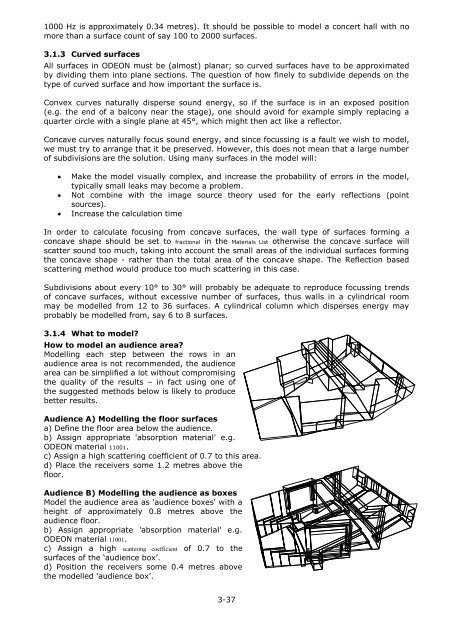Download - Odeon
Download - Odeon
Download - Odeon
You also want an ePaper? Increase the reach of your titles
YUMPU automatically turns print PDFs into web optimized ePapers that Google loves.
1000 Hz is approximately 0.34 metres). It should be possible to model a concert hall with no<br />
more than a surface count of say 100 to 2000 surfaces.<br />
3.1.3 Curved surfaces<br />
All surfaces in ODEON must be (almost) planar; so curved surfaces have to be approximated<br />
by dividing them into plane sections. The question of how finely to subdivide depends on the<br />
type of curved surface and how important the surface is.<br />
Convex curves naturally disperse sound energy, so if the surface is in an exposed position<br />
(e.g. the end of a balcony near the stage), one should avoid for example simply replacing a<br />
quarter circle with a single plane at 45°, which might then act like a reflector.<br />
Concave curves naturally focus sound energy, and since focussing is a fault we wish to model,<br />
we must try to arrange that it be preserved. However, this does not mean that a large number<br />
of subdivisions are the solution. Using many surfaces in the model will:<br />
<br />
<br />
<br />
Make the model visually complex, and increase the probability of errors in the model,<br />
typically small leaks may become a problem.<br />
Not combine with the image source theory used for the early reflections (point<br />
sources).<br />
Increase the calculation time<br />
In order to calculate focusing from concave surfaces, the wall type of surfaces forming a<br />
concave shape should be set to fractional in the Materials List otherwise the concave surface will<br />
scatter sound too much, taking into account the small areas of the individual surfaces forming<br />
the concave shape - rather than the total area of the concave shape. The Reflection based<br />
scattering method would produce too much scattering in this case.<br />
Subdivisions about every 10° to 30° will probably be adequate to reproduce focussing trends<br />
of concave surfaces, without excessive number of surfaces, thus walls in a cylindrical room<br />
may be modelled from 12 to 36 surfaces. A cylindrical column which disperses energy may<br />
probably be modelled from, say 6 to 8 surfaces.<br />
3.1.4 What to model?<br />
How to model an audience area?<br />
Modelling each step between the rows in an<br />
audience area is not recommended, the audience<br />
area can be simplified a lot without compromising<br />
the quality of the results – in fact using one of<br />
the suggested methods below is likely to produce<br />
better results.<br />
Audience A) Modelling the floor surfaces<br />
a) Define the floor area below the audience.<br />
b) Assign appropriate 'absorption material' e.g.<br />
ODEON material 11001.<br />
c) Assign a high scattering coefficient of 0.7 to this area.<br />
d) Place the receivers some 1.2 metres above the<br />
floor.<br />
Audience B) Modelling the audience as boxes<br />
Model the audience area as 'audience boxes' with a<br />
height of approximately 0.8 metres above the<br />
audience floor.<br />
b) Assign appropriate 'absorption material' e.g.<br />
ODEON material 11001.<br />
c) Assign a high scattering coefficient of 0.7 to the<br />
surfaces of the ‘audience box’.<br />
d) Position the receivers some 0.4 metres above<br />
the modelled 'audience box’.<br />
3-37
















